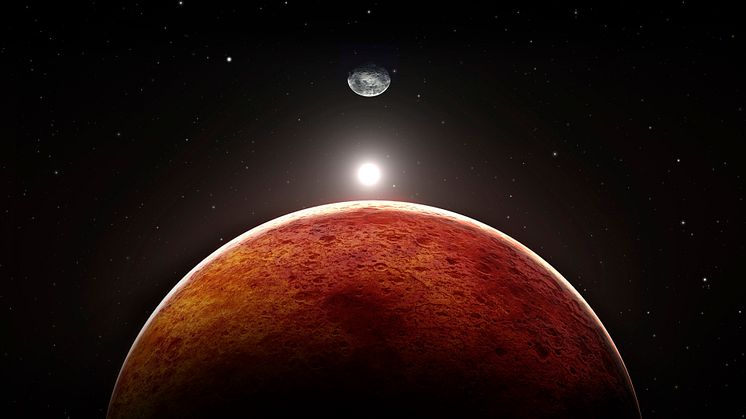
Press release -
COMMENT: Mars: why contamination and planetary protection are key to any search for life
Rodrigo Ledesma-Aguilar, Senior Lecturer in Physics and Electrical Engineering at Northumbria University comments on why contamination and planetary protection are key to any search for life.
It has been over 400 years since Galileo put humankind in its right placein the solar system. By looking at how Jupiter’s moons revolve about the gas giant, he came to the conclusion that Earth was not at the centre but one of many planets revolving around the sun. Similarly, recent evidence that water is likely to flow on Mars means facing the idea that Earth is not the only planet in the solar system to harbour life.
While Galileo’s heliocentric views were met by fierce opposition, finding life on Mars would today spark an unprecedented global scientific revolution on Earth. The immediate (and sensible) response will be a likely boost to the exploration of the red planet. But how should we go about it in an ethical and scientifically considered way – without bringing biological contamination from Earth to the unspoilt environment of Mars?
Where there’s water, there could be life. NASA’s recent discovery of salty traces, thought to come from seasonal water flows, means the race is now on to see actual water flowing on the surface. The salty traces were seen by the Mars Reconnaisance Orbiter – a satellite overlooking the surface of the planet – so were from off-site observations. Current ground missions, including the Opportunity and Curiosity rovers, have so far found no evidence of liquid water on the surface, so future ground missions will now certainly focus on looking for water and testing for the presence of microbial life harboured by liquid water.
NASA’s plans for a manned mission, part of the Journey to Mars programme, could start as early as the 2030s. These could directly confirm, or reject, the possibility of a Martian biosphere within our lifetime. But it may be more difficult than it sounds.
Surviving the extreme
Back in the 1970s, experiments carried out by the Viking landers looked for signatures of biological activity in dust samples from the Martian surface. These famously led to tantalising positive results that were later disproved so any new evidence of life on Mars will have to be thoroughly scrutinised.
The new evidence suggests liquid briny water can exist at temperatures as low as -23°C. This raises important questions about whether biochemical processes can take place in such exotic environments. One possibility could be Martian extremophile organisms, ones that are hardy enough to survive the most extreme environments and could withstand the harsh conditions of the red planet. This might motivate testing for subtler “proto” life forms – organisms similar to viruses, enzymes and prions – similar to those that may have existed on Earth before bacteria and archaea.
Plans will certainly include integrated tests, for example using lab-on-a-chip devices, to search for signature biochemical substances. But perhaps most importantly, newly devised tests will have to consider the effect that native Martian conditions, such as chemistry, radiation levels and temperature, could have on the biochemistry of any lifeforms.
New technologies should be adapted to test for life in areas of Mars of special interest. In fact, the National Academy of Sciences of the USA and the European Space Sciences Committee have already produced a reportforeseeing potential “special regions” of interest apart from sources of briny water, including methane-rich areas, shallow ice-rich deposits and subsurface cavities such as caves.
Terraforming and contamination
But we need to proceed with care. Mars is a pristine environment and we we would need to take into account the potential fragility of Martian life. Earth extremophiles could, in principle, accidentally make the whole journey to Mars as microscopic stowaways and survive on the Martian surface. This could already be the case with current land missions such as the Opportunity and Curiosity rovers, which might be deemed unfit to travel to biologically promising areas due to the hazard of microbial contamination from Earth.
With its thin atmosphere and plummeting temperatures, Mars is a very inhospitable environment for humans. However, the existence of water could open up opportunities for terraforming, a process to modify a planet to have Earth-like conditions. Air and soil humidity are key factors for plant growth and human sustenance and attempts to create a more hospitable environment could start with small, artificially enclosed areas of Earth-like soil pockets immersed in Earth-like atmospheres. Building such structures would pose several engineering challenges to ensure a protective shield against radiation, and to prevent leaks.
Colonisation plans would have to include extensive tests on the viability of organisms from Earth within the extreme Martian environment. For example their resistance to lower gravity and higher radiation levels. However, there are subtler ramifications that might arise from constrained genetic and ecological diversity such as genetic disorders caused by inbreeding.
The prospect of a potential biochemical and ecological clash between Earth and Martian organisms would be the most complex problem so far seen by biologists. Introducing alien species to an indigenous environment could lead to significant adverse effects on the stability of the ecosystem and much like conservation work on Earth, we would have to address the issue of planetary protection.
Incoming organisms might also be susceptible to pathogenic infections from native lifeforms, something we would need to mitigate and plan for.
Beyond Galileo
In a famous letter to Kepler, Galileo complained that sceptic scholars of his celestial observations would not even look through his telescope, thus “shutting their eyes to the light of truth". Sadly, Galileo’s work supporting heliocentrism was eventually banned and the man himself subjected to house arrest by the Inquisition.
This time around nobody will look away. The consistent progress made over the past decades to understand Mars is a signature of a much more cooperative and ideologically open society.
Much like the light that bounced off Jupiter’s moons and came through Galileo’s telescope, the images captured by the Mars Reconnaissance Orbiter have already started unveiling new and exciting information. The truth about Martian life is out there, and it is just a matter of time before we go and find it.
This article was originally published on The Conversation. Read the original article.
Topics
Categories
Northumbria is a research-rich, business-focused, professional university with a global reputation for academic excellence. To find out more about our courses go to www.northumbria.ac.uk
If you have a media enquiry please contact our Media and Communications team at media.communications@northumbria.ac.uk or call 0191 227 4571.








